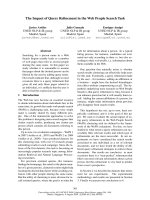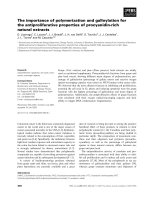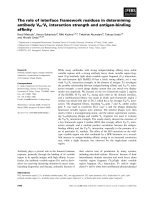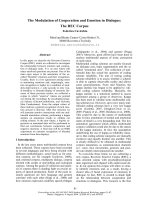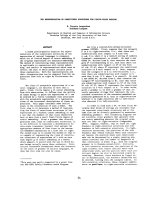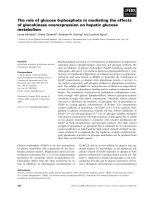Báo cáo khoa học: "The conceptualisation of health and disease in veterinary medicine" pdf
Bạn đang xem bản rút gọn của tài liệu. Xem và tải ngay bản đầy đủ của tài liệu tại đây (228.54 KB, 6 trang )
BioMed Central
Page 1 of 6
(page number not for citation purposes)
Acta Veterinaria Scandinavica
Open Access
Review
The conceptualisation of health and disease in veterinary medicine
Stefan Gunnarsson*
Address: Section of Animal Hygiene, Department of Animal Environment and Health, Swedish University of Agricultural Sciences (SLU), P.O. Box
234, S-532 23 Skara, Sweden
Email: Stefan Gunnarsson* -
* Corresponding author
Abstract
Background: The concept of health, as well as the concept of disease, is central in veterinary
medicine. However, the definitions "health" and "disease" are not generally acknowledged by
veterinarians. The aim of this study was to examine how the concepts "health" and "disease" are
defined in veterinary textbooks.
Methods: Veterinary textbooks in several disciplines were investigated, but only textbooks with
explicit definitions of the concepts were selected for examination.
Results: Eighty out of the 500 relevant books within veterinary medicine were written for non-
veterinarians. Eight percent of the books had an explicit definition of health and/or disease. More
frequently, textbooks written for non veterinarians did have definitions of health or disease,
compared to textbooks written for professionals. A division of health definitions in five different
categories was suggested, namely:
1. Health as normality, 2. Health as biological function, 3. Health as homeostasis, 4. Health as
physical and psychological well-being and 5. Health as productivity including reproduction.
Conclusion: Few veterinary textbooks had any health or disease definition at all. Furthermore,
explicit definitions of health stated by the authors seemed to have little impact on how health and
disease are handled within the profession. Veterinary medicine would probably gain from
theoretical discussions about health and disease.
Background
The concept of health, as well as the concept of disease,
must be regarded as essential to veterinary medicine. Nev-
ertheless, it appears to be uncommon that broader discus-
sions about these basic concepts occur within the
veterinary society. The increasing diagnostic possibilities
to identify diseases make it crucial to define disease and
health, as this basic distinction gives the very fundament
of disease classification.
The naive definition of health in veterinary medicine
seems to be that health is no more than the very absence
of disease, which can be considered as a dichotomous def-
inition. This position is often the case for basic assump-
tions in e.g. epidemiology, where the disease frequency
commonly is calculated based on that disease is binary,
which means that either the animal has the disease or it
does not have the disease.
Published: 07 November 2006
Acta Veterinaria Scandinavica 2006, 48:20 doi:10.1186/1751-0147-48-20
Received: 30 September 2006
Accepted: 07 November 2006
This article is available from: />© 2006 Gunnarsson; licensee BioMed Central Ltd.
This is an Open Access article distributed under the terms of the Creative Commons Attribution License ( />),
which permits unrestricted use, distribution, and reproduction in any medium, provided the original work is properly cited.
Acta Veterinaria Scandinavica 2006, 48:20 />Page 2 of 6
(page number not for citation purposes)
The epidemiological methods used to investigate the
excellence of a disease test, e.g. the sensitivity and the spe-
cificity of a serological method, is built on the understated
assumptions of well-defined concepts of disease and
health. However, it seems to be rare that any evaluation of
diagnostic methods is based on any scrutiny or more pre-
cise definitions. For example in a well known textbook in
veterinary epidemiology quite extended parts of the book
emphasize the theoretical problems associated with diag-
nostic tests [1]. But the concepts of health and disease are
just briefly reviewed and Martin and co-authors refer that
productivity is commonly used as a surrogate definition
of health in veterinary medicine, although this has been
seriously questioned by several others [e.g. [2]].
Pathology has always been an essential part of veterinary
medicine. It is more or less self-evident that the patholo-
gist should be able to determine health from disease in
order to put an accurate diagnosis. Nevertheless, it seems
rare to find any explicit definition of these central con-
cepts or even to find the subject being investigated further.
No matter in what area the veterinarian is active, the daily
work involves, directly or indirectly, health and disease in
animals. Therefore, it is logical to examine how different
concepts of disease are used within veterinary medicine,
and to examine textbooks in veterinary medicine, e.g. vet-
erinary pathology, internal medicine and epidemiology.
The aim of the present study is to examine how the con-
cepts of "health" and "disease" are defined in veterinary
textbooks in pathology, epidemiology, internal medicine
and other areas. Definitions of health and disease found
in various textbooks of veterinary medicine are examined
and categorised. Furthermore, the implications of the dif-
ferent health definitions are discussed.
Methods
The veterinary textbooks at the libraries of the Swedish
University of Agricultural Sciences (SLU) were examined
during the spring of 2003. The literature investigated com-
piled veterinary textbooks in several disciplines, such as
pathology, internal medicine, bacteriology and immunol-
ogy.
The approach of examining the literature was to perform
a scanning of the tables of content, indexes and introduc-
tory chapters of every volume. The scanning was done to
identify any definition or theoretical discussion about
health or disease. Only textbooks with explicit definitions
of health and disease were selected for further examina-
tion. Thus, this study does not investigate implicit defini-
tions of health and disease, as the identification of such
definitions would demand far more advanced analyses, as
well as, there would be an increased risk of getting arbi-
trary definitions.
Results
About 80 out of the 500 relevant books I found within
veterinary medicine were written for non-veterinarians,
such as veterinary nurses, farmers or the common man.
Thirty-nine of the 500 books (8%) comprised any explicit
form of, more or less developed, definition of health and/
or disease. Twenty-two books out of these 39 were written
for veterinarians or veterinary students, five were veteri-
nary dictionaries, two were handbooks for veterinary
nurses and ten were written for farmers or animal owners.
Twenty-five volumes out of the 39 were written in English,
four were in German, five were in Swedish, two were in
Norwegian, two were in Danish and one volume were
written in French.
Four out of 39 volumes were available in several editions.
These different editions were counted as single hand-
books, and special attention was paid to any added or
extended health or disease definition. Different editions
revealed an extended or modified definition of health [3-
7]. Other handbooks had unchanged text sections about
health/disease throughout several editions, e.g. a German
textbook for veterinary nurses [8-10].
A higher proportion of textbooks written for non-veteri-
narians contained definitions of health or disease, com-
pared to textbooks written for veterinarians (15% versus
7%). The three textbooks about alternative veterinary
medicine with explicit health definition were all written
for laymen and specifically covered homeopathic treat-
ment of animals [11-13]. These books were not only giv-
ing a definition of health from the point of view of
alternative veterinary medicine, but also a health defini-
tion of what the authors saw as conventional medicine,
which they rejected. However, there were no references to
other publications in these books.
Most books had only one single definition of health or
disease. The exception was, apart from the books in alter-
native medicine, a dictionary of veterinary medicine
where alternative definitions of health were given [14,15].
Discussion
Few veterinary textbooks had any health definition at all.
In general, common textbooks of pathology were lacking
any suggestion of how to define health and disease. Typi-
cally, the textbooks of pathology and internal medicine
comprised chapters about each system of organs, i.e. one
chapter about diseases of the integument, one about dis-
ease of the respiratory system, one about disease of the
digestive system and so on. These textbooks contained
contributions from several authors, responsible for text
Acta Veterinaria Scandinavica 2006, 48:20 />Page 3 of 6
(page number not for citation purposes)
sections of the diseases of an organ system or a group of
diseases. Then the book chapters were put together by the
editors [e.g. [16,17]].
Categories of health definitions
A subdivision of health definitions is in itself arbitrary.
However, such a division may increase the possibility to
comprehend heterogeneous items of more or less devel-
oped definitions of health and disease. The subdivision
presented here should be regarded as a tool to bring order
in this study, rather than to establish a definition of
schools of the subject once and for all.
Different approaches to the concept of health and disease
were found in the literature reviewed and they can be split
into the following five categories:
1. Health as normality
2. Health as biological function
3. Health as homeostasis
4. Health as physical and psychological well-being
5. Health as productivity including reproduction
1 Health as normality
It seems common to define health and disease in terms of
normality or abnormality. However, definitions referring
to health as normality were usually very limited in their
extension and sometimes only fragments were found. An
example of normality definition comes from a manual for
animal health auxiliary personnel written by the Food and
Agriculture Organization of the United Nations [18],
where a healthy animal is described to have a normal
appearance and behaviour. The animal should have nor-
mal features, including normal body position and move-
ments. This definition is actually not a definition of the
concept of health as such, but an operational definition of
clinical health, assuming normality.
John Webster [19] has a similar approach to health in his
disease definition which relates disease to a normal state
and that "ill health always appear as departure from nor-
mality". Webster also puts our attention to the impor-
tance of getting clinical experience of the normal health
animal in order to understand the normal variation of
healthy animals.
In a German veterinary dictionary 'disease' is defined as a
disturbance of the normal function of the body [20]. A
similar definition is given by Arnall and Keymer [21], who
define health as a soundness of the body and an absence
of disease, which assume that there is a normality of
health. However, the authors are referring to diverse defi-
nitions of health without giving a clear opinion of their
own.
Baker and Greer [22] give a semantic analysis of the dis-
ease concept before they propose a normality-based
health concept. They define disease "as 'not at ease'
because the prefix 'dis' denotes reversal or separation from
the root 'ease'. Animal ill health is synonymous with the
word 'disease'."
In the previous definitions there are clearly stated
attempts to base the health concept on normality, but ele-
ments of biological function can also be introduced as rel-
evant to normality definition [22,23]. Particularly Baker
and Greer [22], in a passage about that "structural defect
or functional impairment of the animal body", implies
that they do not only define health as normality, but that
they also think that health is linked to a biological func-
tioning.
2 Health as biological function
Slauson and Cooper [24] propose in their textbook about
comparative pathology that disease can be seen as a man-
ifestation of malfunctioning physiology or physiology
that has gone wrong. They think that disease ultimately
reflects structural or functional alteration in the cells of
which all living things are made, which is the common
idea within pathology.
Gillespie and Timoney [25] give a similar definition of
disease, namely that a disease is defined disturbances of
proper performance of body functions, or as they put it:
"Disease may be defined as an alteration of the state of the
body, or of some of its organs, which interrupts or dis-
rupts the proper performance of the bodily functions.
Functional disturbance soon is manifested by physical
signs which usually can be detected by others."
The pathologist Norman F. Cheville [26] expresses that
veterinary pathology is abnormal biology in a wide sense,
and that "pathology is essentially the search for and the
study of lesions, the abnormal structural and functional
changes that occur in the body."
The idea of health as based on biological functioning is
related to the idea of homeostasis, which could be said to
develop the idea of functioning more precise by setting
the boundaries of functioning.
3 Health as homeostasis
Health defined as homeostasis is an old idea, but still it is
a common way of looking at health and disease. The con-
cept of homeostasis is related to the maintenance of a del-
icate balance within the organism or within the processes
Acta Veterinaria Scandinavica 2006, 48:20 />Page 4 of 6
(page number not for citation purposes)
in the organism. Here is one example: "Disease arises
when the normal interplay of the body functions is dis-
turbed. It is depending on the constitution of the organ-
ism, on the disposition for disease and on the disease
causes that influence the body, e.g. infectious agents, envi-
ronmental factors, toxic substances and alteration of
nutrients" [[8-10], translated from German by the
author].
The idea of homeostasis seems so firmly established
within the discipline of physiology that it is not just
regarded as an approach to describe physiological proc-
esses; it is considered to be a law of nature in the same way
as the idea of evolution is viewed as a law of nature not a
biological theory.
The idea of health as homeostasis is commonly used
within veterinary homeopathy. In the three homeopathy
books found, the discussions about health were quite
extended and the homeostasis idea was contrasted to the
assumed ideas of conventional medicine. The homeosta-
sis idea was expressed as being holistic, which can be illus-
trated by Christopher Day [12], who writes about
homeopathic veterinary medicine in comparison to con-
ventional medicine, as he looking at it.
"In holistic terms, the word 'health' implies the concept of
a mind and body together in harmony with the environ-
ment. When the organism, comprising the mind and the
body, is out of the harmony within itself or with its envi-
ronment, then we have the state of disease (literally dis-
ease).
Modern conventional medicine tends to view disease as a
set of signs and symptoms, recognisable combinations of
which are called 'disease'. Each of these given a name and
is assumed to have an identity of its own. In holistic med-
icine we view disease differently. We see the signs or
symptoms simply as a result of, and expression of the
body's reaction to, the disease forces which impinge upon
it, threatening to disturb its internal equilibrium. Like all
systems in equilibrium, the body – a very sensitive and
active equilibrium system-reacts to disturbing forces in an
attempt to retain or regain balance." [12]
Homeopathic health definitions are often stated to be
"holistic" and based on the idea that health is depending
on homeostasis. However, as health definition found in
conventional veterinary textbooks also can be based on
the homeostasis idea, it can not be deduced that homeo-
static thinking logically leads to homeopathic medicine.
One example of this is that Lagerlöf, Hallgren and Ekesbo
[27] define health as a state where all organs are in a deli-
cate balance within the organism and with the surround-
ing world. This definition has been further refined by
Ekesbo [27,28]. The authors Lagerlöf, Hallgren and
Ekesbo clearly belong to classic veterinary medicine and
not the homeopathic school.
4 Health as physical and psychological well-being
It is common in the debate about animal welfare to pro-
pose definitions of health that includes psychological
aspects of health [2,29,30]. However, it seems uncommon
that welfare and well-being are included in the health def-
initions in veterinary textbooks. One exception is Martin
and co-authors [1] that start off with giving references to
the human health definition stated by the World Health
organisation (WHO), i.e. that health is "a state of com-
plete physical, mental, and spiritual well being", but they
also think that productivity is a substantial part of health
in farm animals.
If health is defined as physical and psychological well-
being, there are problems associated with applying the
definition to all animals. Domestic animals are more or
less subordinate to human interests and this is most obvi-
ous regarding farm animals. A health definition that puts
priority to the physical and psychological well-being of an
animal is misleading in relation to the general purpose of
livestock production.
In their veterinary dictionary, Blood and Studdert [14,15]
express similar thoughts as Martin and co-workers [1], as
they claim that health is "a state of physical and psycho-
logical well-being and of productivity including reproduc-
tion". Although this definition is very short, it mixes two
different approaches to health, which could be regarded
as contradictory. At first there may not be any conflict
between well-being and productivity, but how do we
make priority between these two aspects if they are in con-
flict. Are both parts necessary to fulfil in order to be
healthy? This dual health definition leads us to the last
category of health definitions, which includes productiv-
ity aspects.
5 Health as productivity including reproduction
The previous definitions could be seen as universal, i.e.
the health definitions could be applied to all animals
including humans. However, it would probably be hard
to use a health definition that equalises health to produc-
tivity, as a general health definition for humans or other
non-producing animals, e.g. pets.
The idea that health in animals solely is the same as pro-
ductivity is quite uncommon in the literature, although it
is e.g. proposed by C. S. G. Grunsell in Black's veterinary
dictionary [31], where it is stated that health "is now more
accurately regarded as a state of maximum economic pro-
duction".
Acta Veterinaria Scandinavica 2006, 48:20 />Page 5 of 6
(page number not for citation purposes)
Even if it is rare to define health purely in productivity
terms, several authors incorporate elements of reproduc-
tion and productivity in their definition of health for farm
animals. For example, Aspinall [32] states that "a healthy
animal grows, reproduces, and behaves in a manner
which has come to be regarded as normal for its species
and type".
In the book "Veterinary medicine: A textbook of the dis-
eases of cattle, sheep, pigs, goats & horses" [available in
several editions e.g. [7]], it is proposed that disease tradi-
tionally has been defined as "abnormality of structure or
function" and that it has long been widened to embrace
subclinical diseases. Furthermore, it is reported that the
concept of disease also includes "failure to produce" at
expected level of nutritional supply and environmental
quality. But the authors also declare that "the detection of
residues of disqualifying chemical in foods of animal ori-
gin will also come to be included within the scope of dis-
ease". This extended definition of health is not just
relevant to the individual animal but also cover the envi-
ronmental effects.
David Sainsbury [33] proposes a slightly modified health
definition related to productivity. He introduces the term
"positive health", which he defines as" the provision of a
complete diet, an environment that is optimal for the ani-
mal's physiological needs, comfortable to the animal's
senses, in which the animal is secure and free from fear,
and with no undue challenge by pathogenic micro-organ-
isms or predators". Sainsbury's definition is interesting as
it is not just a describing health, but the definition is also
normative, i.e. telling us how health should be. He claims
that "good health is the birthright of every animal that we
rear, whether intensively or otherwise". He is also extend-
ing health beyond the subjective health state of the ani-
mal, as he argues that medication to control disease is not
giving true health to the animal although the animal
appears to be healthy.
General discussion
It was rare that veterinary textbooks gave explicit defini-
tions of health and disease. The main reason for that may
be that the general purpose of the textbooks was not to
investigate what is healthy or what is diseased in principle,
but to describe diseases and their causes and conse-
quences.
It was common that textbooks use different aspects of
health definition [20]. This makes it harder to actually
know what the main health idea is in a textbook. When an
explicit definition of health was presented in a textbook it
was almost always given without references to other
health definitions. It can be assumed that the reason for
this is that the authors were focused on the general topic
of the book and not philosophy of health.
The general debate of welfare in animals was never
referred in veterinary textbooks within this study, and the
authors seemed to write in isolation from other authors'
definition of health and disease. However, there were
exceptions from this in the books of veterinary homeopa-
thy. All three books about veterinary homeopathy found
were referring to what the authors found as incorrect
health definitions, i.e. the mechanistic approach they
attributed the school of classic veterinary medicine [11-
13].
Homeopathic health definitions were stated to be 'holis-
tic' and were mainly based on the idea that health is
depending on homeostasis. However, as health definition
of conventional veterinary textbooks also could be based
on the homeostasis idea, it can not be concluded that
'homeostasis thinking' logically leads to homeopathic
medicine, as mention above. This observation may illus-
trate that the basic theory behind a health definition do
not have inevitable consequences for the veterinary prac-
tice. It seems like the explicit definition of health stated by
an author had little or no impact on how health and dis-
ease were handled within the profession.
Veterinary medicine would probably gain on a more
intense discussion about the concept of health. A veteri-
narian that never contemplates the health concept would
merely be an "animal mechanic", who just needs to find
out in what way the animal is broken, and then fix it
according to the manual. If the concepts of health and dis-
ease were more clearly defined, the communication of e.g.
zoonotic hazards to the public would become more
robust. Furthermore, the general discussion of animal
welfare issues would become more relevant if the basic
concepts of health and disease were more commonly pen-
etrated in the debate.
Conclusion
The concepts of health and disease are rarely given explicit
definitions in veterinary textbooks. The definitions found
could be split into five categorised of health definitions.
There was no obvious connection between stated health
definition and medical approach, i.e. classic veterinary
medicine or alternative veterinary medicine. Veterinary
medicine would gain from a broader theoretical discus-
sion about health and disease.
Competing interests
The author(s) declare that they have no competing inter-
est.
Publish with Bio Med Central and every
scientist can read your work free of charge
"BioMed Central will be the most significant development for
disseminating the results of biomedical research in our lifetime."
Sir Paul Nurse, Cancer Research UK
Your research papers will be:
available free of charge to the entire biomedical community
peer reviewed and published immediately upon acceptance
cited in PubMed and archived on PubMed Central
yours — you keep the copyright
Submit your manuscript here:
/>BioMedcentral
Acta Veterinaria Scandinavica 2006, 48:20 />Page 6 of 6
(page number not for citation purposes)
Acknowledgements
This work was conducted as a part of the project "Health and welfare in
the world of animals and humans" in collaboration with Bo Algers at SLU
Skara, Lennart Nordenfelt, Henrik Lerner and Anders Nordgren at the Uni-
versity of Linköping, and Ingemar Lindahl at the University of Stockholm.
The project was funded by the Swedish Council for Working Life and Social
Research (FAS), grant no. 2001-2317.
References
1. Martin SW, Meek AH, Willeberg P: Veterinary epidemiology: Principles
and methods Ames, Iowa, USA, Iowa State university press; 1987.
2. Broom DM: Animal Welfare Defined in Terms of Attempts to
Cope with the Environment. Acta Agric Scand Sect A, Animal Sci
Suppl 1996, 27:22-28.
3. Blood DC, Henderson JA: Veterinary medicine 4th edition. London,
Baillière Tindall; 1974.
4. Blood DC, Henderson JA, Radostits OM: Veterinary medicine: A text-
book of the diseases of cattle, sheep, pigs & horses 5th edition. London,
Baillière Tindall; 1979.
5. Blood DC, Radostits OM: Veterinary medicine: A textbook of the diseases
of cattle, sheep, pigs, goats & horses 7th edition. London, Baillière Tin-
dall; 1989.
6. Radostits OM, Blood DC, Gay CC: Veterinary medicine: A textbook of
the diseases of cattle, sheep, pigs, goats & horses 8th edition. London,
Baillière Tindall; 1994.
7. Radostits OM, Gay CC, Blood DC, Hinchcliff KW: Veterinary medicine:
A textbook of the diseases of cattle, sheep, pigs, goats & horses 9th edition.
London, Baillière Tindall; 2000.
8. Geyer G, Grabner A: Die Tierarzthelferin; Leitfaden für den Fachkunde-
unterricht der Tierarzthelferin; Kurzgefasster Ratgeber für Tierarztfrauen
und Helfer in der Praxis 1st edition. Schlütersche Verlagsanstalt und
Druckerei; 1983.
9. Geyer G, Grabner A: Die Tierarzthelferin; Leitfaden für den Fachkunde-
unterricht der Tierarzthelferin; Kurzgefasster Ratgeber für Tierarztfrauen
und Helfer in der Praxis 3rd edition. Schlütersche Verlagsanstalt und
Druckerei; 1988.
10. Geyer G, Grabner A: Die Tierarzthelferin; Leitfaden für den Fachkunde-
unterricht der Tierarzthelferin; Kurzgefasster Ratgeber für Tierarztfrauen
und Helfer in der Praxis 4th edition. Schlütersche Verlagsanstalt und
Druckerei; 1991.
11. Brock K, Nielsen J: Veterinær homøopati – En indførning i homøopatisk
diagnostik og terapi på dyr København, DSR Forlag Landbohøjskolen;
1986.
12. Day C: The homeopathic treatment of beef & dairy cattle Beaconsfield,
Bucks, England, Beaconsfield publishers Ltd; 1995.
13. Thoresen AS: Veterinærmedisin alternative metoder – funksjonell veter-
inærmedisin med grunnlag i en helhetlig anskuelse Oslo; 1997.
14. Blood DC, Studdert VP: Baillière's Comprehensive Veterinary Dictionary
1st edition. London, Baillière Tindall; 1988.
15. Blood DC, Studdert VP: Saunders comprehensive veterinary dictionary
2nd edition. London, WB Saunders; 1999.
16. Thomson RG: Special veterinary pathology Toronto, BC Decker Inc;
1988.
17. Ettinger SJ, Feldman EC: Textbook of veterinary internal medicine: dis-
eases of the dog and cat Volume 1&2. 5th edition. Philadelphia, WB
Saunders company; 2000.
18. FAO: Manual for animal health auxiliary personnel Rome, Food & Agri-
culture Organization of the United Nations; 1983.
19. Webster J: Understanding the dairy cow Worcester, Great Britain, BSP
Professional Books; 1987.
20. Wiesner E, Ribbeck R: Wörterbuch der Veterinärmedizin 2nd edition.
Stuttgart, Gustav Fischer Verlag; 1983.
21. Arnall L, Keymer IF: Bird disease; an introduction to the study of birds in
health & disease London, t.f.h; 1975.
22. Baker JK, Greer WJ: Animal health: A layman's guide to disease control
Danville, Illinois, IPP The Interstate Printers & Publishers Inc; 1980.
23. Hoopes KH, Thwaits RN: Principles of veterinary science Baltimore,
USA, Williams & Wilkins; 1997.
24. Slauson DO, Cooper BJ: Mechanisms of disease: A textbook of compar-
ative general pathology 2nd edition. Baltimore, USA, Williams &
Wilkins; 1990.
25. Gillespie JH, Timoney JF: Hagan and Bruner's infectious diseases of
domestic animals; with reference to etiology, pathogenicity, immunity, epi-
demiology, diagnosis, and biologic therapy 7th edition. Itaca, N.Y., USA,
Cornell University Press; 1981.
26. Cheville NF: Introduction to veterinary pathology Ames, Iowa, Iowa State
University Press; 1988.
27. Lagerlöf N, Hallgren W, Ekesbo I: Husdjurens hälso-och sjukvårdslära.
(Handbook of animal health and animal care) 3rd edition. Stockholm,
Sweden, LTs förlag; 1968.
28. Ekesbo I: Kompendium i husdjurshygien (Compendium in Animal Hygiene)
8th edition. Skara, Sweden, Department of Animal Environment and
Health, Swedish University of Agricultural Sciences (SLU); 2002.
29. Duncan IJH: Animal welfare defined in terms of feelings. Acta
Agric Scand Sect A, Animal Sci Suppl 1996, 27:29-35.
30. Fraser D, Weary DM, Pajor EA, Milligan BN: A scientific concep-
tion of animal welfare that reflects ethical concerns. Animal
Welfare 1997, 6:187-205.
31. West GP: Black's veterinary dictionary 18th edition. London, A&C
Black; 1995.
32. Aspinall KW: First step in veterinary science London, Baillière Tindall;
1976.
33. Sainsbury D: Farm animal welfare; Cattle, pigs & poultry London, Collins;
1986.
